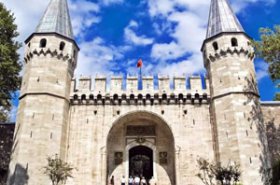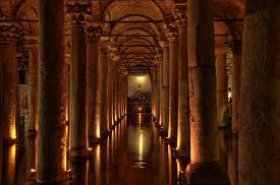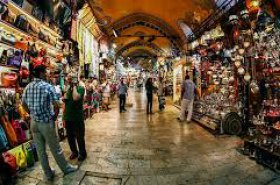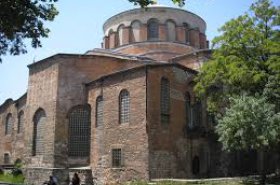A Brief History of Istanbul

Topkapı Palace
The Topkapı Palace or the Seragliois a large palace in Istanbul, Turkey, that was one of the ma ... Read More
The Topkapı Palace or the Seragliois a large palace in Istanbul, Turkey, that was one of the major residences of the Ottoman sultans for almost 400 years (1465–1856) of their 624-year reign.
As well as a royal residence, the palace was a setting for state occasions and royal entertainments. It is now a museum and as such a major tourist attraction. It also contains important holy relics of the Muslim world, including Muhammed's cloak and sword. The Topkapı Palace is among the monuments contained within the "Historic Areas of Istanbul", which became a UNESCO World Heritage Site in 1985, and is described under UNESCO's criterion iv as "the best example[s] of ensembles of palacesof the Ottoman period.

Blue Mosque
The Sultan Ahmed Mosque or Sultan Ahmet Mosque (Turkish: Sultan Ahmet Camii) is a historic mosque ... Read More
The Sultan Ahmed Mosque or Sultan Ahmet Mosque (Turkish: Sultan Ahmet Camii) is a historic mosque in Istanbul. The mosque is popularly known as the Blue Mosque for the blue tiles adorning the walls of its interior.
It was built from 1609 to 1616, during the rule of Ahmed I. Its Külliye contains a tomb of the founder, a madrasah and a hospice. The Sultan Ahmed Mosque is still popularly used as a mosque.

Hagia Sophia
Hagia Sophia is a former Christian patriarchal basilica (church), later an imperial mosque, and n ... Read More
Hagia Sophia is a former Christian patriarchal basilica (church), later an imperial mosque, and now a museum (Ayasofya Müzesi) in Istanbul, Turkey. From the date of its construction in 537 until 1453, it served as an Orthodox cathedral and seat of the Patriarch of Constantinople, except between 1204 and 1261, when it was converted to a Roman Catholic cathedral under the Latin Empire. The building was a mosque from 29 May 1453 until 1931. It was then secularized and opened as a museum on 1 February 1935

Basilica Cistern
The Basilica Cistern is the largest of several hundred ancient cisterns that lie beneath the city ... Read More
The Basilica Cistern is the largest of several hundred ancient cisterns that lie beneath the city of Istanbul (formerly Constantinople), Turkey. The cistern, located 500 feet (150 m) southwest of the Hagia Sophia on the historical peninsula of Sarayburnu, was built in the 6th century during the reign of Byzantine Emperor Justinian I.

Grand Bazaar
The Grand Bazaar in Istanbul is one of the largest and oldest covered markets in the world, with ... Read More
The Grand Bazaar in Istanbul is one of the largest and oldest covered markets in the world, with 61 covered streets and over 3,000 shops which attract between 250,000 and 400,000 visitors dailyIn 2014, it is listed No.1 among world's most-visited tourist attractions with 91,250,000 annual visitors.

Spice Market
There are several documents suggesting the name of the bazaar was first "New Bazaar". T ... Read More
There are several documents suggesting the name of the bazaar was first "New Bazaar". The building was endowed to the foundation of the New Mosque, and got its name "Egyptian Bazaar" (Turkish: Mısır Çarşısı) because it was built with the revenues from the Ottoman eyalet of Egypt in 1660. The word mısır has a double meaning in Turkish: "Egypt" and "maize". This is why sometimes the name is wrongly translated as "Corn Bazaar". The bazaar was (and still is) the center for spice trade in Istanbul, but in the last years more and more shops of other type are replacing the spice shops.

Hagia Eirene Church
Hagia Irene or Hagia Eirene (Greek: Ἁγία Εἰρήνη, "Holy ... Read More
Hagia Irene or Hagia Eirene (Greek: Ἁγία Εἰρήνη, "Holy Peace", Turkish: Aya İrini), sometimes known also as Saint Irene, is an Eastern Orthodox church located in the outer courtyard of Topkapı Palace in Istanbul, Turkey. It is open as a museum every day except Tuesday.

Aya Sergios ( Küçük Ayasofya - Litle Hagia Sophia )
The Küçük Ayasofya Mosque was originally constructed as a church located between ... Read More
The Küçük Ayasofya Mosque was originally constructed as a church located between the Cankurtaran and Kadırga Neighborhoods of the Eminönü District by the Byzantine Emperor Justinian I (527-565). The mosque, built in the year 530 CE, called the Church of Sts. Sergius and Bacchus, was converted into a mosque during the reign of Sultan Bayezit II after the conquest of Istanbul by Darüssaade Ağası (overseer of the sultan’s harem), Hüseyin Ağa. After its convertion into a mosque, the zaviye (cell for meditation) around the atrium and Hüseyin Ağa’s tomb were built.
The domed mosque, composed solely of stone and brick atop a square plan, was damaged by an earthquake twice during the years 1648 and 1763. Reparations followed in 1831. Furthermore, the nearby railway constructed in1860 has impaired further construction to a large extent. In addition, it is thought that the old minaret of the mosque was erected in Baroque style after the second half of the 18th century. However, it was later pulled down for an unknown reason in 1936, and the existing minaret was added to the mosque in 1955. The octagonal historical marble fountain in the atrium was later removed in 1938.







